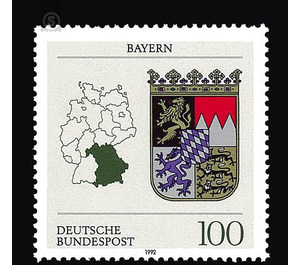Coat of arms of the Land of the Federal Republic of Germany (1) - Germany / Federal Republic of Germany 1992 - 100 Pfennig
Theme: Art & Culture
| Country | Germany / Federal Republic of Germany |
| Issue Date | 1992 |
| Face Value | 100.00 |
| Color | multi-colored white |
| Perforation | K 13 3/4 |
| Printing Type | Multicolor offset printing |
| Stamp Type | Postage stamp |
| Item Type | Stamp |
| Chronological Issue Number | 1460 |
| Chronological Chapter | GER-BRD |
| SID | 792109 |
| In 59 Wishlists | |
The special postal stamp does not show the complete "Great State Emblem" of the Free State. The two lions are missing as shield holders. For graphic reasons, only the central blazon was highlighted and thus the series with the other country coat of arms equaled. The Bavarian coat of arms was introduced in its present form in 1950 by law. It goes back to the first coat of arms of the Kingdom of Bavaria from 1806. This already showed the diamonds and the lion as a shield holder. In four fields it symbolizes the Bavarian parts of the country. The white-blue heart shield in the center of the state emblem puts the entirety of the Bavarian state in the foreground. With these symbols, Bavaria tied to exemplary, old traditions and at the same time underlines the historically grown stability of the Länder in the Federal Republic of Germany. Over the coat of arms of Bavaria rested the row of the people crowns, which points to the sovereignty of the citizens of the free state and documents at the same time the democratic self-understanding. In the upper left quarter of the coat of arms, the golden lion in the black field points to the districts of old Bavarian Upper Palatinate. This was "borrowed" by the Wittelsbachs. The three silver peaks visible against a red background - right next to it - represent the Franconian government districts of Bavaria. The "Frankish rake" goes back to the Würzburg prince-bishops. On the lower left you can see a "blue panther" on a silver background - a heraldic mythical creature of the Count Palatine of Ortenburg, who comes from Lower Bavaria. This sign stands for the old Bavarian government districts of Lower and Upper Bavaria. The right lower part of the coat of arms depicts three black lions on a gold background. This heraldry comes from the Hohenstaufen, who already had this coat of arms as »Dukes of Swabia«. The lions represent the tribe of the Swabians in Bavaria. The heart shield - in the middle of the coat of arms - is probably the most famous Bavarian landmark (Small Bavarian coat of arms). The rhombuses - actually called "awakening" - come from the coat of arms of the Bavarian Counts von Bogen - a family based on the Danube near Regensburg. The origin goes back to the year 1204. In 1242, Wittelsbacher, who was related to the Count of Bogen, took over their possessions and the state emblem after the extinction of the Bogen family. On recent history: When the Free State of Bavaria in 1923 sought a national coat of arms for the new republic, the idea of symbolizing the tribes prevailed. The Volkskrone should also duly convey the transition of sovereignty from the Wittelsbachs to the Bavarian people. For a better understanding: The term »Free State« does not contain any Bavarian special rights. It is merely the translation of the word »republic«. The Free State of Saxony has now adopted this »state name«. The special postage stamp also outlines the geographical location of Bavaria in federal Germany. With 70,500 km2 (around 11 million inhabitants), Bavaria is the largest German federal state in terms of area - a modern industrial country with a rich tradition. It should and wants to remember the special stamp. (Text: Bavarian State Ministry for Federal and European Affairs, Representation of the Free State of Bavaria at the Federal Government, Bonn)


